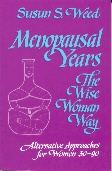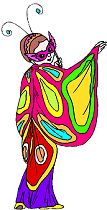Wise Woman herbal and home remedies are simple, safe ways to
help yourself when you have a diagnosis of uterine fibroids.
Uterine fibroids are solid muscle tissue growths in the uterus. They
are also called fibroid tumors, myomas, or leiomyomas. Fibroids occur
so frequently (in up to half of all women over forty) that they could
be considered a normal irregularity. The occasional fibroid can become
enormous (medical literature reports one that was 100 pounds!), but
the majority (80%) remain as small as a walnut.
Fibroids are the number one reason American women have hysterectomies.
The causes of uterine fibroids are unknown, but estrogens, especially
estradiol, promote their growth. After menopause fibroids disappear.
But because estrogen levels can rise during the early menopausal years,
previously asymptomatic fibroids may grow in the years just before the
cessation of menses, resulting in symptoms such as feeling of heaviness
in the belly, low back pain, pain with vaginal penetration, urinary
frequency or incontinence, bowel difficulties, or severe menstrual pain
and flooding.
Women of color are three to nine times more likely to have fibroids
than white women, and theirs will grow more quickly.
Fibroid tumors are not cancer, not malignant. Tumor means a swelling
or a growth, not a malignancy, not cancer. Less than 0.1% of all uterine
fibroids are malignant.
Small fibroids often disappear spontaneously. Larger fibroids are more
difficult to resolve, but not impossible to control with natural measures.
• The “root chakra” (lowermost energy center in the
body, which includes the uterus) said to store unexpressed anger. It
is believed that any unwanted growths in these organs can be countered
by allowing the anger to safely discharge.
• One woman’s fibroids (and menstrual cramps) disappeared
within three months of beginning a vigorous exercise program. Exercise
helps insure regular ovulation, and irregular ovulation seems to worsen
fibroids.
• Consuming three or more servings of whole grains or beans daily
not only reduces the size of fibroids but offers protection from breast
and endometrial cancers as well.
• Red clover flowers (Trifolium pratense), are one of my favorite
infusions, but use during the menopausal years may increase difficulty
with fibroids.
• Strengthening the liver with herbs such as dandelion, milk thistle
seed, or yellow dock root helps it metabolize estrogen out of the body,
thus reducing fibroids.
• Vitex or chasteberry tincture, 25-30 drops two to four times
daily, often shrinks small fibroids within two months. But results come
from long-term use — up to two years.
• Ask someone to burn moxa over the area of the fibroid while
you envision the heat releasing the treasures in your uterus. What is
locked up in this fibroid? What can you give birth to?
• Acupuncture treatments can shrink fibroids.
• Poke root (Phytolacca americana), used internally as a tincture
(1-10 drops per day; start small) and externally as a belly rub oil,
has gained a reputation as a profound helper in relieving pain and distresses
from fibroids. CAUTION: Poke is considered poisonous; it is not often
found for sale. This is one remedy you may have to make yourself to
try.
• Warm castor oil packs on the belly, or ginger compresses (soak
a towel in hot ginger water) relieve pain and help shrink the fibroids.
• The use of progesterone to treat women with uterine fibroids
is hotly debated. One side holds that fibroids are created by lack of
progesterone. The other side makes, to my mind, the better case: that
progesterone increases fibroids. Evidence? Fibroids increase in size
during pregnancy, when progesterone production is high, and atrophy
after menopause, when progesterone levels decrease. Whichever side is
right, eating more whole grains and beans usually changes estrogen/progesterone
ratio for the better and shrinks fibroids.
• Reduce fibroids by reducing your exposure to estrogen: avoid
birth control pills, ERT/HRT, estrogen-mimicing residues from herbicides
and pesticides used on food crops (eat organically- raised products).
Tampons that are bleached with chlorine may mimic the bad effects of
estrogen, too.
• Lupron (leuprolide acetate), a drug which induces “artificial
menopause”by shutting down the body's production of estradiol causes
a significant decrease in fibroid size within 8-12 weeks. Fibroids do
regrow to about 90 percent of their original size when the drug is withdrawn
however.
• Major advances have been made in surgical treatments for women
with fibroids. There are many options now besides hysterectomy (removal
of the uterus), including hysteroscopic resection, uterine embolization,
myomectomy, and suprecervical hysterectomy. Since these are fairly new
procedures, take the time to find a surgeon who is skilled in the procedure.
• Hysterectomy can be a life-saving procedure, but by the age
of sixty, more than one-third of American women will have given up their
wombs to the surgeons. The presence of non- symptomatic fibroids is
never sufficient reason, to my mind, for a hysterectomy. Of my students
and apprentices who have had hysterectomies because of fibroids, those
who “did their homework” — that is, helped themselves
before and after their surgery with all the tools at their disposal
— seemed to fare much better than those who did not.
• With very few exceptions, no woman is healthier without her
ovaries. So, even if you elect a hysterectomy, keep your ovaries.
These Wise Woman ways, and lots more, are in my book New Menopausal
Years the Wise Woman Way, available from www.wisewomanbookshop.com.
They are arranged in order of risk: the safest first, the most dangerous
last. If you have a uterine fibroid and it is a problem, begin with
the mildest remedies first. Set a time limit for your use of any remedy,
but, except in an emergency, don't go on to stronger remedies until
you are sure the safer ones aren't effective for you. As with any advice,
you are the best judge of what works for you.

If you liked this excerpt by Susun S.
Weed, you will want
NEW Menopausal Years the Wise Woman Way:
 Alternative Approaches for Women 30 - 90
Alternative Approaches for Women 30 - 90
by Susun S. Weed
Foreword by Juliette de Bairacli Levy.
304 pages, index, magical illustrations.
Completely revised with 100 new pages. All the remedies women know and trust plus hundreds of new ones. New sections on thyroid health, fibromyalgia, hairy problems, male menopause, and herbs for women taking hormones. Recommended by Susan Love MD and Christiane Northrup MD.
Retails for $27.95
Read Juliette de Levy-Bairacli's introduction:
This
book should be in the hands of every woman, of every race,
no matter
what age, worldwide.
Read some excerpts:
Building Better Bones
Kundalini Meditation
Order New Menopausal Years in our Bookshop
"If this book had not been given to me by a close friend, I would be experiencing menopause in an entirely different manner. The Wise Woman approach to the various and unexpected discomforts and joys of the Change has motivated me to seize this experience to transform my life for the better."
